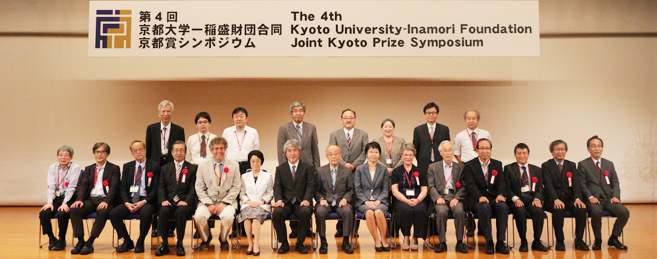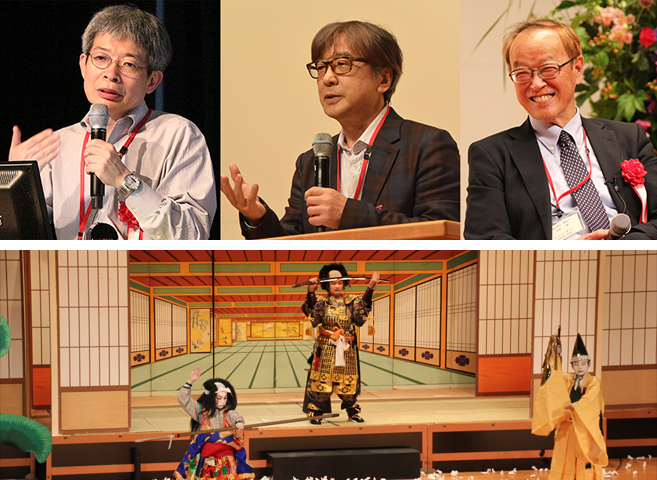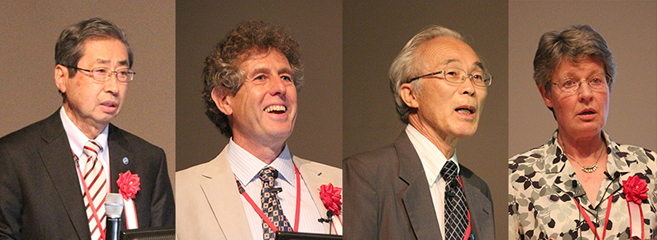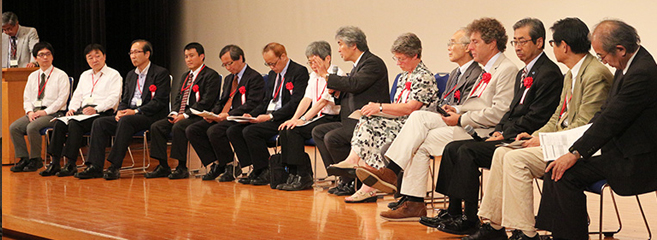Archives
4th Kyoto University-Inamori Foundation Joint Kyoto Prize Symposium
July 1-2, 2017


The fourth Kyoto University-Inamori Foundation Joint Kyoto Prize Symposium (KUIP) was held at the Clock Tower Centennial Hall on 1 and 2 July.
Under the theme “Art, Science and Technology to Inspire Dreams and Adventure”, this year’s symposium highlighted three fields of study related to the 2019 Kyoto Prize: “Materials Science and Engineering”, “Earth and Planetary Sciences, Astronomy, and Astrophysics”, and “Theater, Cinema”. The two-day event brought together 11 leading experts and one organization. Lively discussion over cutting-edge topics took place, garnering attention not only from academic circles, but also from the community at large. Around 700 students, researchers, and members of the general public attended.
On the first day, a session on “Theater, Cinema” was held on the topic of “Why Do People Perform? — The Meaning of Art for Homo Sapiens/Human Beings –“. Yokozen Kabuki Children’s Workshop (Nagi Board of Education, Okayama Prefecture) opened the session by performing the “Amagasaki Scene” from the 10th act of the kabuki play The Picture Book of the Taiko. Then, three speakers delivered lectures: Oriza Hirata, playwright/director and specially-appointed professor at the Center for the Study of CO Design, Osaka University; Shinichi Nakazawa, anthropologist and director of the Institut pour la Science Sauvage, Meiji University; and Kazuki Omori, director/writer and professor at the Osaka University of Arts. Professor Shoko Suzuki of the KU Graduate School of Education joined them as a moderator. The speakers discussed evocative topics, such as the fundamental meaning of acting and performing in rituals, ceremonies, or movies, and the meaning of performance and art for human beings in the modern age.
On the morning of the second day, the “Materials Science and Engineering” session was held with the theme: “Investigation of New Materials for a Sustainable Future”. The session featured four speakers: Susumu Kitagawa, distinguished professor and deputy director-general of the KU Institute for Advanced Study (KUIAS) and director of the Institute for Integrated Cell-Material Sciences (iCeMS); Shanhui Fan, professor at Stanford University; Yoshinori Tokura, director of RIKEN Center for Emergent Matter Science and professor at the University of Tokyo; and Hideo Ohno, director and professor at the Research Institute of Electrical Communication, Tohoku University. The speakers discussed interdisciplinary investigation of materials from perspectives specific to pioneering researchers in their fields, such as “chemistry and nano space”, “nanophotonics and its fusion with topological science”, “strongly correlated electron systems and superconduction/magnetism”, and “semiconductors and magnetism”.
The “Earth and Planetary Sciences, Astronomy and Astrophysics” session was held on the topic of “A Renewed Sense of Wonder Toward the Earth and the Universe” on the afternoon on the second day. The session featured: Asahiko Taira, president of Japan Agency for Marine-Earth Science and Technology; Tim Palmer, Royal Society Research Professor (350th Anniversary) at the University of Oxford; Katsuji Koyama, professor emeritus at Kyoto University; and Jocelyn Bell Burnell, professor at the University of Oxford. They talked about their adventurous journeys to realize their wild dreams, covering topics such as: how they produced academic achievements by making full use of cutting-edge equipment such as riser drilling vessels and super-computers in deep earth research and weather pattern predictions; how they discovered supernovae and pulsars by digging into their creativity, and using the radiotelescope to grasp what is happening in the farthest reaches of the universe.
The symposium wrapped up with a joint closing session. Moderated by KU President Juichi Yamagiwa, the speakers from the three sessions and program committee members took the stage to offer thought-provoking insights. Many of the speakers stated that they were inspired with the lectures, and renewed their sense of the importance of cross-disciplinary exchange, especially with those in other fields. Some speakers pointed out the difference in attitudes toward “compromise” between the science and technology field, in which no compromise is allowed, and the field of art, in which compromise is acceptable. Some also argued that joining the circle of world-leading universities would be difficult for Japanese universities as they do not have a good understanding of art and rarely have museums or theaters, which are standard for universities in Europe and the United States.
Audience feedback included: “The lectures about theater and cinema covered a variety of topics, and were quite interesting”; “The session changed my view on theater”; “I learned a lot about how things evolve from the current reality toward the possible future, and how people can realize technologies that were supposed to be just a dream”; and, “I found that the people’s power to dream and their sense of wonder are the common in the field of ‘theater and cinema’, discussed in the first day session, and a wide range of scientific research from the nano world to the origin of the universe discussed in the second day session.”
Day 1July 1(Sat.), 2017
Opening Ceremony
「夢とロマンをはぐくむ芸術および科学・技術」
Arts and Philosophy
“Theater, Cinema”

From left: Professor Hirata, Director Nakazawa, and Professor Omori
“Why Do People Perform?
- The Meaning of Art for Homo Sapiens/ Human Beings -”
Why do people perform? Since ancient times, human beings have done so in rites and ceremonies, as well as in the context of mutual relationships. The performance of social roles expected of people living in groups has also been a human occupation, with men becoming fathers, women becoming mothers, and people becoming various kinds of workers at different stages in their lives. In this symposium, we will return to the essential significance of performance and explore what it means for us living today while investigating more generally the role of art in human life.
●Speakers
- Yokozen Kabuki Children’s Workshop (Nagi Board of Education, Okayama Prefecture)
- “The 10th Act: The Amagasaki Scene from the Kabuki Play The Picture Book of the Taiko”
- Oriza Hirata (Playwright, Director/Specially Appointed Professor, Center for the Study of CO Design, Osaka University)
- “Theater as a Communication Device”
- Shinichi Nakazawa (Anthropologist/Director, Institut pour la Science Sauvage, Meiji University)
- “The Logos and Lemma of Art”
- Kazuki Omori (Director, Writer/Professor, Osaka University of Arts)
- “When Human Performance Disappears from Movies”
Day 2July 2(Sun.), 2017
Advanced Technology
“Materials Science and Engineering”

“Investigation of New Materials for a Sustainable Future”
The development of new science sometimes occurs at the frontiers between different academic fields. This session explores the frontiers between several such fields, including photonics and topology, strongly correlated electron systems and superconduction/magnetism, semiconductors and magnetism, and chemistry and nanospaces, in the search of new materials. Leading researchers in each of these fields give presentations and speak of their dreams and adventures.
●Speakers
- Susumu Kitagawa (Distinguished Professor, Deputy Director-General, Kyoto University Institute for Advanced Study/Director, Institute for Integrated Cell-Material Sciences, Kyoto University)
- “Gas Science and Technology for Sustainable Future”
- Shanhui Fan (Professor, Stanford University)
- “Nanophotonics and Its Fusion with Topological Science: Synthetic Gauge Potential for Light”
- Yoshinori Tokura (Director, RIKEN Center for Emergent Matter Science/Professor, The University of Tokyo)
- “Strong Correlation between Electricity and Magnetism in Materials”
- Hideo Ohno (Director, Professor, Research Institute of Electrical Communication, Tohoku University)
- “Spintronics -From Synthesis of III-V Magnetic Semiconductors to VLSI Applications-”
Basic Sciences
“Earth and Planetary Sciences, Astronomy and Astrophysics”

“A Renewed Sense of Wonder toward the Earth and the Universe”
Since ancient times, we human beings have been deeply connected to the earth and the universe. Although they have at times inflicted disaster upon us, they have also been the source of blessings and comfort, and inspired a sense of wonder. In recent years, the dramatic development of science and technology has given us a more detailed grasp of the earth and the universe, resulting in broader curiosity and deeper understanding. For example, researchers have: retrieved core samples from across the 2011 Tohoku Earthquake slip surface; used supercomputers to conduct numerical weather predictions over a week and climate projections for the 21st century; and made astronomical observations of radio waves and X-rays from the earth’s surface and from satellites. In these and other ways, the presenters speaking at this symposium have accepted the challenge of addressing some of the many unknowns that characterize the earth and the universe. Their work broadens and deepens our knowledge while generating new feelings of wonder.
●Speakers
- Asahiko Taira (President, Japan Agency for Marine-Earth Science and Technology (JAMSTEC))
- “Plate Tectonics, Japanese Islands and Chikyu”
- Tim Palmer (Royal Society (350th Anniversary) Research Professor,University of Oxford)
- “From Determinism to Probability: Development of the Ensemble Prediction Technique for Weather and Climate Forecasting”
- Katsuji Koyama (Professor Emeritus, Kyoto University)
- “X-Ray Study of a Kyoto Millennium Supernova”
- Jocelyn Bell Burnell (Professor, University of Oxford)
- “Cosmic Fireworks - Finding Transient Events in the Universe”
Closing Session

Inviting President Juichi Yamagiwa of Kyoto University, cross-disciplinary discussion will be made among invited speakers and program committee members.










